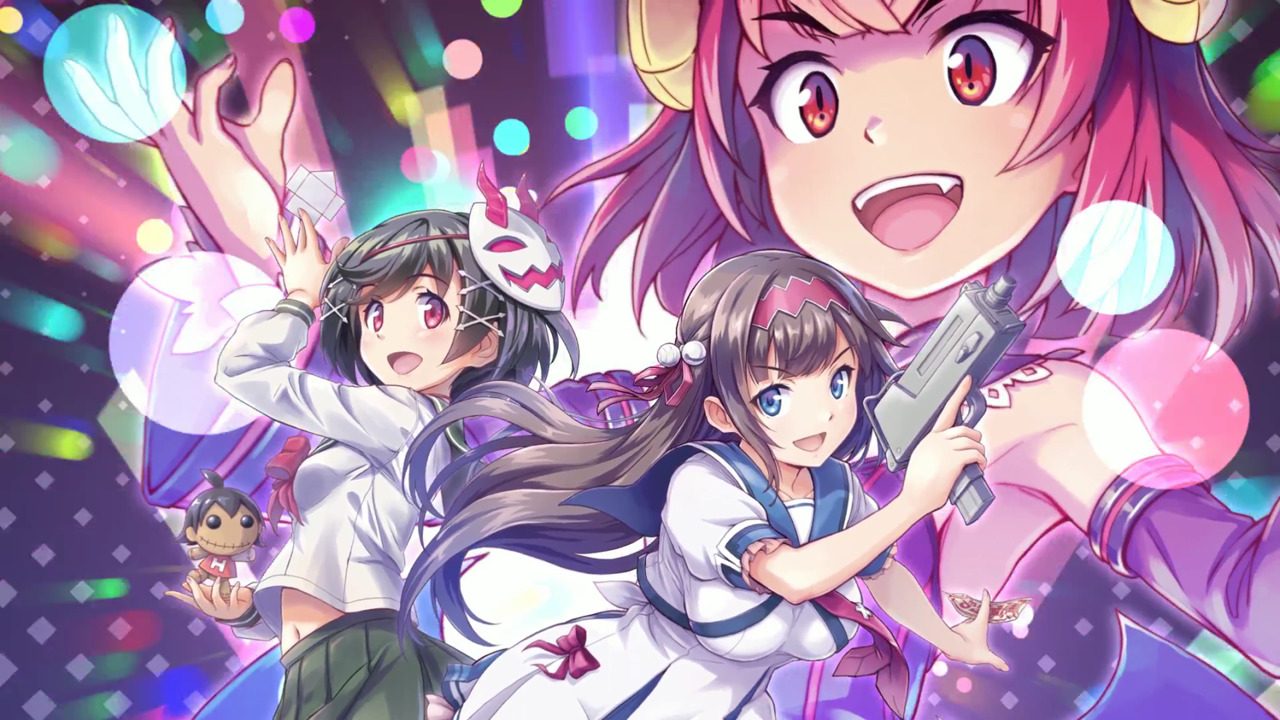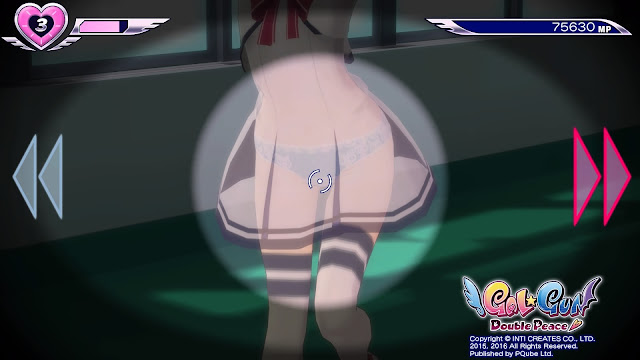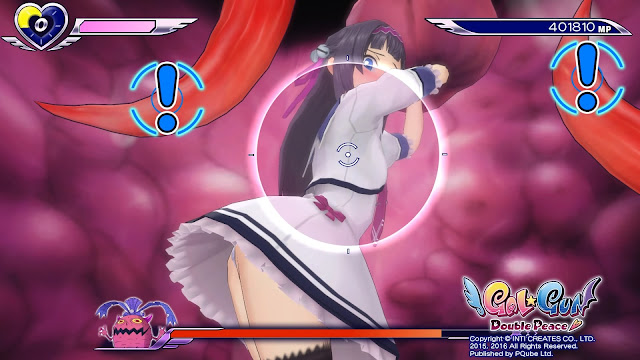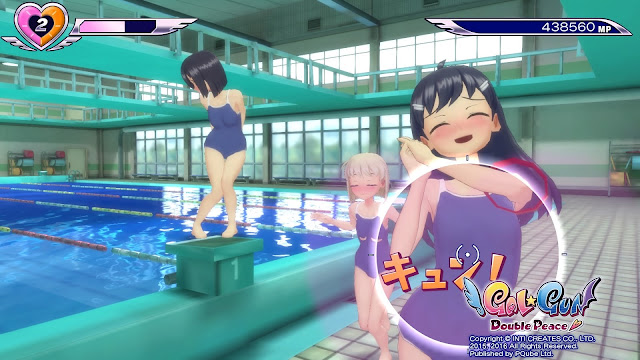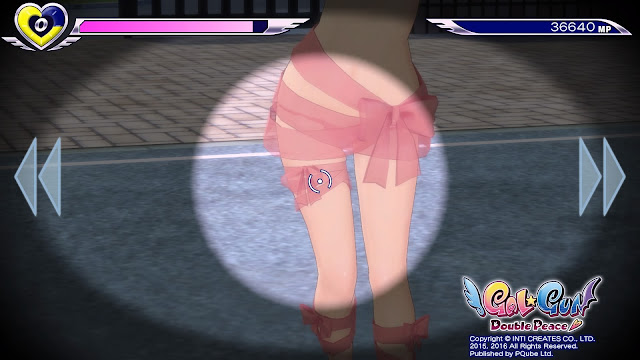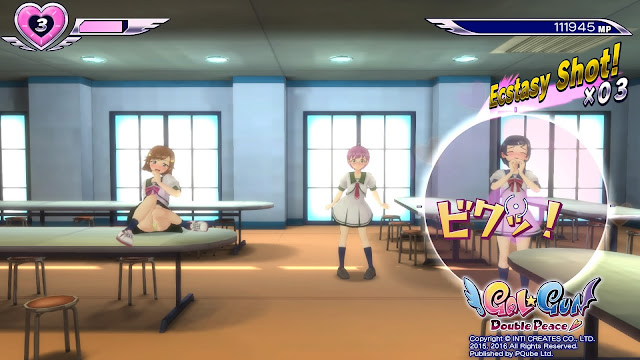Let’s get something clear, right off the bat: Gal*Gun: Double Peace is a lewd, hypersexualised, fanservice-riddled game, and it never pretends to be anything else. At the same time, it has a level of self-awareness and subversiveness that also makes it a rather brilliant satire of such games and of objectification in general—not to mention a critique of Western games’ obsession with violence.
Related reading: Matt’s review of Gal*Gun: Double Peace.
Gal*Gun puts a twist on the rail shooter genre by taking away bullets and killing and replacing them with… “pheromoe shots” and “euphoria”. After a Cupid angel-in-training accidentally shoots the main character, Houdai, with a supercharged love arrow, every girl in school becomes enamored with him. However, if he doesn’t confess to his true love by the end of the day, he’s doomed to be forever alone. His lovestruck coeds certainly don’t make that easy, but at least he has one way of fending them off: a magical gun that essentially shoots projectile orgasms.
With a setup like that and its abundance of panty-shots, double entendres, and general titillation, Gal*Gun certainly comes across as a smutty game that objectifies women. However, this is a jumping-off point for a potent satire of “pervy anime games” in which characters are fundamentally not objectified—sexualised, yes, but not objectified. Objectification is something more complex, involving various aspects of autonomy and interchangeability. An objectified character is one that can be easily replaced with another similar object with little to no impact.
A quick glance or a surface reading will very quickly show you a game with heavily objectified women. Hordes of near-identical, generically sexy women swarm you, only so that you can shoot them some “euphoria”, take a quick look at their panties, and move on. Only, these aren’t just generic enemies for you to hit and quit; there are 70 or so different girls and women, all unique, and excelling at Gal*Gun actually requires you to get to know them.
At the most basic level, each girl has a different weak point—either head, chest, hips, or legs. Hitting a sensitive spot counts as an “Ecstasy Shot”, instantly giving them euphoria, removing the threat they pose, and giving you a better score. If you’re aiming at a weak spot, an icon will show up to indicate that fact, but there are plenty of times when you don’t have enough time to go searching. You only have a brief moment to make your shot count, so guess what? Being able to recognise at a glance which individual girl it is and knowing where that particular girl is sensitive is a key to getting good scores.
Another important scoring mechanic is something called “Doki-Doki mode”, a mini-game of sorts that has you fondling girls in order to give them euphoria. Now, you could fumble around aimlessly like a drunk one-night stand in the dark, but you’re not going to achieve very much. But if you actually know the girl you’re feeling up as someone who’s more than just a target for your sex cannon, you’re going to have a much better time—as will she—and you’ll get a better score. Some girls like it when you play with their hair, or stroke their cheeks. Some like it when you slap their butt. Some just straight up want you to rub their crotch.
(I feel like I should point out here that Doki-Doki mode isn’t nearly as explicit as I’ve made it sound. It’s suggestive but quite mild, really; you basically just move a cursor around and watch the girl’s reactions to see if you’re touching her in a way she likes.)
Finally, there are quests. Before each level, you’re given a handful of requests from other students, typically asking you to find something or meet someone. Sometimes, the requests are pretty straightforward—“I think I left my camera in a cardboard box by the road” makes it clear where you’re going to find the target item. But there are plenty where the clues are much more vague, and if you want to complete the request by any means other than trial and error, you need to—you guessed it—get to know your fellow students.
When your only clue to find the sushi that you’re looking for is that there’s a Swedish exchange student who really likes sushi, you need to know not just who the Swedish exchange student is, but where you might find her and what makes her visually distinct. Likewise when you need to speak to someone who always smells like coffee because she works at a cafe, or someone who loves robot model kits. Character profiles found throughout the game have all this information readily available, but it’s up to you to find those profiles and make use of them.
That is, I think, the most genius thing about Gal*Gan: a game that initially presents its sexualised women as objects in the most literal sense—as target dummies with boobs—requires you to actually get to know them as people, as individuals, if you want to do well.
Then there’s the actual storyline, which plays out more or less like a typical visual novel / dating sim. Early on, you get to choose your true love, either Shinobu or Maya—sisters whom Houdai’s known since childhood, and who are immune to his newfound aphrodisiac aura—and the rest of the game has you trying to find the right time to tell them. The actual plot beats are quite ridiculous—you actually have to fight a tentacle monster at one point—but the character arcs for Shinobu and Maya are genuinely heartfelt and moving.
Moreover, trying to get the true ending for either of them again requires you to get to know them as people, so that you can choose the most appropriate responses during dialogue sequences and improve your relationship. This is all very typical of dating sims, even the more risque bishōjo ones, but the juxtaposition with the unashamed raunchiness of the shooting mechanics makes this noteworthy.
On top of all this, Gal*Gun frequently takes aim at the men who objectify and demean women. It never misses a chance to make jokes at the expense of “creeps” and “perverts”. Of course, there’ll certainly be plenty such men in the audience for a game that’s basically about making anime girls orgasm. This is something that’s not lost on Gal*Gun; I can’t think think of any other game that takes so much joy in teasing its own target demographic. Sometimes, it’s a lighthearted comments, like being told “don’t use it… for… you know… NAUGHTY stuff!” when purchasing an item. At other times, it’ll just flat out call you a creep because you thought the appropriate dialogue response to a girl sharing her feelings was “can I touch your boobs?”.
In fact, your character has a “Lewdness” stat, alongside the dating sim staples of Intelligence, Athleticism, and Style. The latter three are generally useful in that they open extra dialogue choices, many of which are necessary for getting the best endings. High Lewdness, on the other hand, just lets you pick the most crass speech options, ensuring you get smacked down—usually in hilarious fashion—while pretty much ensuring you get the worst ending possible.
The best part, though, is a little something called Pheromone Z. This is an optional add-on for Gal*Gun that costs a whopping $90 USD, substantially more than the game itself. For a piece of DLC. But it’s priced that way as commentary, I’m certain. What you get for this significant amount of money is an upgrade that lets you “see through clothes instantly” with your gun’s zoom function. Keep in mind you can already see through clothes and get a cheeky peek at girls’ underwear even without Pheromone Z, it just takes a moment and the clothes only go semi-transparent. There’s even an upgrade available within the game, no DLC required, that makes the effect a bit stronger.
Pheromone Z simply goes one further by making clothes completely transparent instead of mostly transparent, and having it happen instantly. It doesn’t let you see through underwear; it doesn’t take Gal*Gun anywhere beyond the “suggestive titillation” that it’s already providing. It’s useless, basically, but people will drop $90 in the hopes of getting some vague hint of anime tiddies. It’s essentially a pervert tax, it knows it, and it wants to make people think twice before shelling out for it.
For all its subversiveness, however, Gal*Gun still presents as a carelessly hypersexualised game in a medium that continues to struggle with how it treats women. Sure, that’s part of what this game is satirising, but you have to actually play it and read between the lines to really see that. For the casual observer walking past it in a shop or seeing advertising materials boasting about its 400+ underwear designs, it just looks like another crass game that treats its women like sex objects.
As relevant as the old adage “don’t judge a book by its cover” may be, people still do, and so people will see Gal*Gun off as yet another “pervy anime game” that feeds into video games’ problem with how women are represented. It’s a real shame, because by writing it off like that, people are missing out on a sharp, hilarious satire of those very games—and just a really good rail shooter in general.

